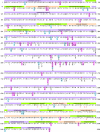Spontaneous mutations in the Plasmodium falciparum sarcoplasmic/ endoplasmic reticulum Ca2+-ATPase (PfATP6) gene among geographically widespread parasite populations unexposed to artemisinin-based combination therapies
- PMID: 20956593
- PMCID: PMC3019649
- DOI: 10.1128/AAC.01156-10
Spontaneous mutations in the Plasmodium falciparum sarcoplasmic/ endoplasmic reticulum Ca2+-ATPase (PfATP6) gene among geographically widespread parasite populations unexposed to artemisinin-based combination therapies
Abstract
Recent reports on the decline of the efficacy of artemisinin-based combination therapies (ACTs) indicate a serious threat to malaria control. The endoplasmic/sarcoplasmic reticulum Ca(2+)-ATPase ortholog of Plasmodium falciparum (PfSERCA) has been suggested to be the target of artemisinin and its derivatives. It is assumed that continuous artemisinin pressure will affect polymorphism of the PfSERCA gene (serca) if the protein is the target. Here, we investigated the polymorphism of serca in parasite populations unexposed to ACTs to obtain baseline information for the study of potential artemisinin-driven selection of resistant parasites. Analysis of 656 full-length sequences from 13 parasite populations in Africa, Asia, Oceania, and South America revealed 64 single nucleotide polymorphisms (SNPs), of which 43 were newly identified and 38 resulted in amino acid substitutions. No isolates showed L263E and S769N substitutions, which were reportedly associated with artemisinin resistance. Among the four continents, the number of SNPs was highest in Africa. In Africa, Asia, and Oceania, common SNPs, or those with a minor allele frequency of ≥0.05, were less prevalent, with most SNPs noted to be continent specific, whereas in South America, common SNPs were highly prevalent and often shared with those in Africa. Of 50 amino acid haplotypes observed, only one haplotype (3D7 sequence) was seen in all four continents (64%). Forty-eight haplotypes had frequencies of less than 5%, and 40 haplotypes were continent specific. The geographical difference in the diversity and distribution of serca SNPs and haplotypes lays the groundwork for assessing whether some artemisinin resistance-associated mutations and haplotypes are selected by ACTs.
Figures



Similar articles
-
Genetic diversity and lack of artemisinin selection signature on the Plasmodium falciparum ATP6 in the Greater Mekong Subregion.PLoS One. 2013;8(3):e59192. doi: 10.1371/journal.pone.0059192. Epub 2013 Mar 26. PLoS One. 2013. PMID: 23555629 Free PMC article.
-
Geographic structuring of the Plasmodium falciparum sarco(endo)plasmic reticulum Ca2+ ATPase (PfSERCA) gene diversity.PLoS One. 2010 Feb 25;5(2):e9424. doi: 10.1371/journal.pone.0009424. PLoS One. 2010. PMID: 20195531 Free PMC article.
-
Investigations into the role of the Plasmodium falciparum SERCA (PfATP6) L263E mutation in artemisinin action and resistance.Antimicrob Agents Chemother. 2010 Sep;54(9):3842-52. doi: 10.1128/AAC.00121-10. Epub 2010 Jun 21. Antimicrob Agents Chemother. 2010. PMID: 20566762 Free PMC article.
-
Updates on k13 mutant alleles for artemisinin resistance in Plasmodium falciparum.J Microbiol Immunol Infect. 2018 Apr;51(2):159-165. doi: 10.1016/j.jmii.2017.06.009. Epub 2017 Jun 29. J Microbiol Immunol Infect. 2018. PMID: 28711439 Review.
-
Spatial and molecular mapping of Pfkelch13 gene polymorphism in Africa in the era of emerging Plasmodium falciparum resistance to artemisinin: a systematic review.Lancet Infect Dis. 2021 Apr;21(4):e82-e92. doi: 10.1016/S1473-3099(20)30493-X. Epub 2020 Oct 27. Lancet Infect Dis. 2021. PMID: 33125913
Cited by
-
Artemether resistance in vitro is linked to mutations in PfATP6 that also interact with mutations in PfMDR1 in travellers returning with Plasmodium falciparum infections.Malar J. 2012 Apr 27;11:131. doi: 10.1186/1475-2875-11-131. Malar J. 2012. PMID: 22540925 Free PMC article.
-
Ecotope-based entomological surveillance and molecular xenomonitoring of multidrug resistant malaria parasites in anopheles vectors.Interdiscip Perspect Infect Dis. 2014;2014:969531. doi: 10.1155/2014/969531. Epub 2014 Oct 1. Interdiscip Perspect Infect Dis. 2014. PMID: 25349605 Free PMC article. Review.
-
Questions over high frequency of mutant PfATP6 haplotypes in traveller isolates.Malar J. 2012 Jun 8;11:186. doi: 10.1186/1475-2875-11-186. Malar J. 2012. PMID: 22681876 Free PMC article.
-
Characterization of the Plasmodium falciparum sarcoplasmic/endoplasmic reticulum Ca2+-ATPase gene in samples from Equatorial Guinea before implementation of artemisinin-based combination therapy.Am J Trop Med Hyg. 2013 Jan;88(1):43-47. doi: 10.4269/ajtmh.2012.12-0364. Epub 2012 Nov 26. Am J Trop Med Hyg. 2013. PMID: 23185077 Free PMC article.
-
In vitro sensitivity of Plasmodium falciparum from China-Myanmar border area to major ACT drugs and polymorphisms in potential target genes.PLoS One. 2012;7(5):e30927. doi: 10.1371/journal.pone.0030927. Epub 2012 May 31. PLoS One. 2012. PMID: 22701513 Free PMC article.
References
-
- Anderson, T. J., B. Haubold, J. T. Williams, J. G. Estrada-Franco, L. Richardson, R. Mollinedo, M. Bockarie, J. Mokili, S. Mharakurwa, N. French, J. Whitworth, I. D. Velez, A. H. Brockman, F. Nosten, M. U. Ferreira, and K. P. Day. 2000. Microsatellite markers reveal a spectrum of population structures in the malaria parasite Plasmodium falciparum. Mol. Biol. Evol. 17:1467-1482. - PubMed
-
- Bacon, D. J., A. M. McCollum, S. M. Griffing, C. Salas, V. Soberon, M. Santolalla, R. Haley, P. Tsukayama, C. Lucas, A. A. Escalante, and V. Udhayakumar. 2009. Dynamics of malaria drug resistance patterns in the Amazon Basin region following changes in Peruvian national treatment policy for uncomplicated malaria. Antimicrob. Agents Chemother. 53:2042-2051. - PMC - PubMed
-
- Bwijo, B., A. Kaneko, M. Takechi, I. L. Zungu, Y. Moriyama, J. K. Lum, T. Tsukahara, T. Mita, N. Takahashi, Y. Bergqvist, A. Bjorkman, and T. Kobayakawa. 2003. High prevalence of quintuple mutant dhps/dhfr genes in Plasmodium falciparum infections seven years after introduction of sulfadoxine and pyrimethamine as first line treatment in Malawi. Acta Trop. 85:363-373. - PubMed
Publication types
MeSH terms
Substances
LinkOut - more resources
Full Text Sources
Miscellaneous

